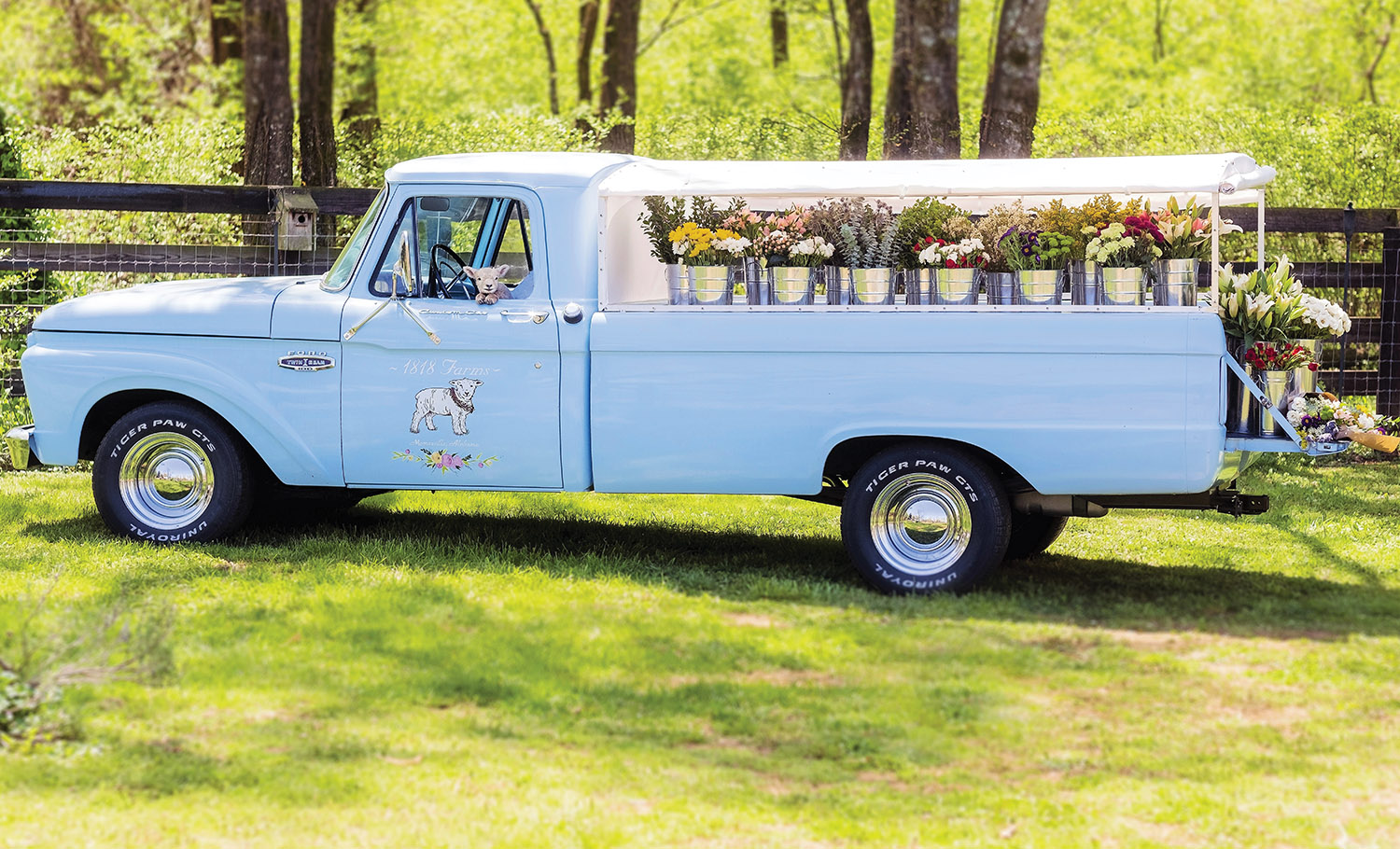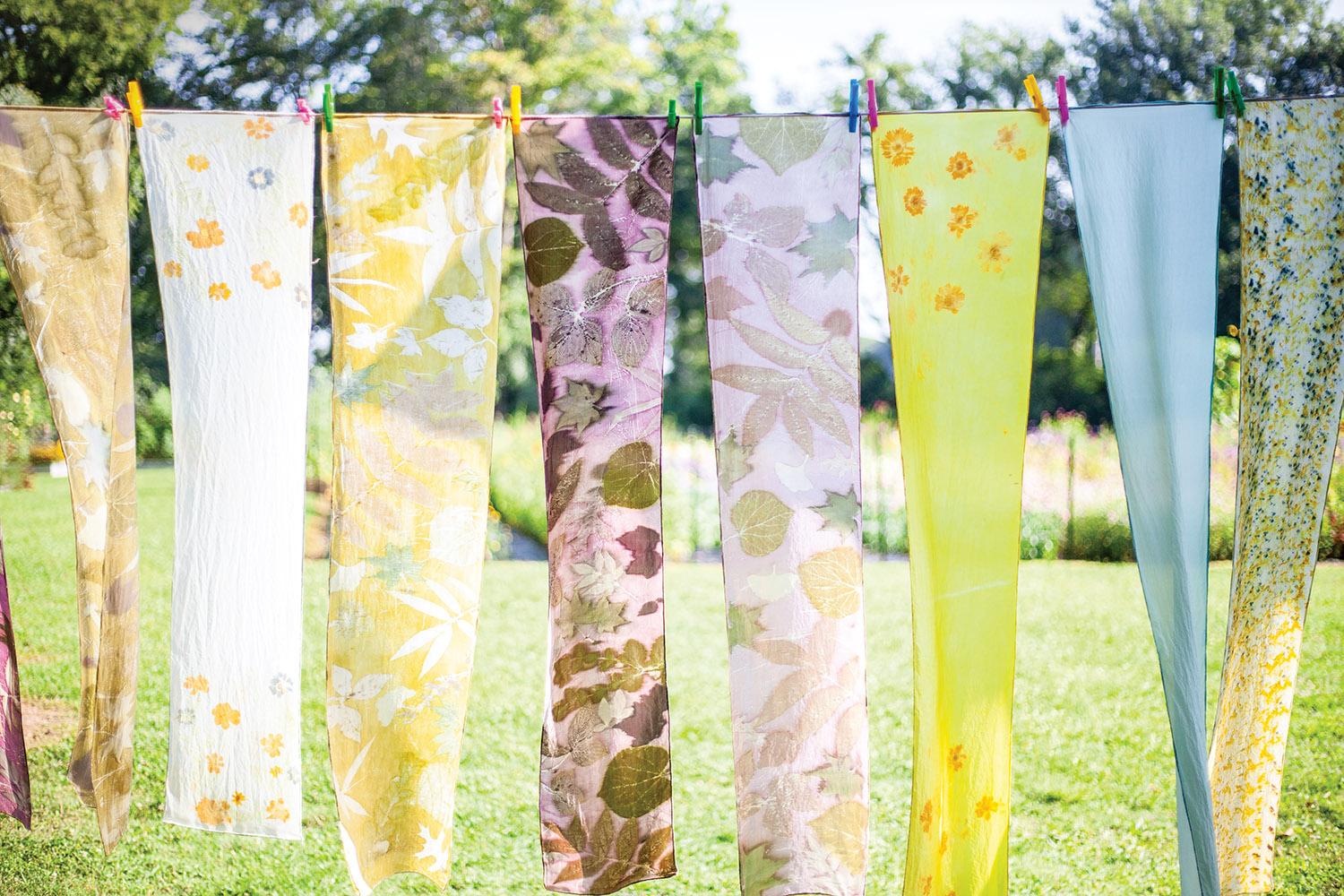
Photo courtesy of 1818 Farms
Natasha McCrary stands among her ranunculus blossoms in the flower fi eld. She starts the plants covered in the winter, then allows them to sunbathe when the threat of frost has passed.
Just off Interstate 565 sits a small town of only 58 residents. Sometimes called the Williamsburg of Alabama due to its Federal style architecture, the community of Mooresville predates the founding of the state by one year. For resident Natasha McCrary, this idyllic village presented an opportunity to launch a small business on a plot of land just around the corner from her house. “I started the farm to teach my children respect for the land, as well as to show them how a small business works,” she says.
Named for the year the town was established, 1818 Farms began with a handful of sheep and chickens but has since expanded to include a host of other animals; an assortment of farm-related, educational events; a line of handmade, hand-packaged bath and beauty products; and a strong focus on growing seasonal flowers—about 15,000 of them each year. There’s even a flower subscription service that includes delivery by Natasha herself in a restored 1965 Ford F100.
Natasha and her family, including husband Laurence who is a sixth-generation Mooresville resident, enjoy growing a variety of blooms, including tulips, dahlias, Pacific Giant delphiniums, Madam Butterfly snapdragons, campanula, strawflowers, French carnations, and Sweet William. “When I began planning the farm, it was important to me to make it sustainable,” Natasha says. “Seed collection, especially of heirloom flowers, is one way we do that. We also do a lot of propagating to maximize the number of flowers we produce. We strive for zero waste, so we forecast how many blooms we will need each season.”

Photo courtesy of 1818 Farms
A vintage Ford pickup carries flowers that Natasha delivers to her flower subscription customers.
In a farm building near the flower fields is a drying room, complete with a dehumidifier, where Natasha works with blooms grown specifically for the purpose of being dried. “The flowers in this room have to be kept in a really dry environment,” she says. “You can’t enjoy them in a vase first and then dry them properly. They have to go straight from the field to the drying room.” The dried flowers include weld, dyer’s chamomile, coreopsis, cosmos, madder root, scabiosa, and bachelor’s buttons. Natasha also stews some of them into natural dyes that she uses in the textile arm of her business. The botanicals give softly saturated hues to the cotton and silk scarves that the farm sells. In another application, Natasha’s team presses leaves gathered from the farm onto silk to create oneof-a-kind wearable art. Designs come from trees and plants such as dogwood, redbud, black walnut, pecan, maple, ginkgo, ferns, and eucalyptus.

Photo courtesy of 1818 Farms
Natasha emphasizes sustainability on the farm, ensuring that no blooms go to waste. Here, she works with zinnias, preparing them for use in her floral prints.

Photo courtesy of 1818 Farms
Zinnias are Natasha's favorite because of their saturated colors.

Photo courtesy of 1818 Farms
From May through October, 1818 Farms sells “Grower’s Choice” flowers by the bucket.
One of Natasha’s favorite things to do is welcome visitors to the farm. “We love showing them around and helping them understand the scope of our work,” she says. Along the way, guests are introduced to the dozen or so Southdown Babydoll sheep that call 1818 Farms home. As beneficiaries of the farm’s success, they are a potent and adorable advertisement for Natasha’s business plan. Hens also peck around in the barnyard, and a Great Pyrenees keeps a watchful eye over it all.

Photo courtesy of 1818 Farms
Natasha conceived the idea of “Where I Bloom” floral collages in the shape of each of the 50 states. The collages are photographed and then printed in a high-resolution giclée process that renders the flowers in minute detail.
The most recent addition to the business is a cottage that Natasha acquired. It overlooks the flowers and sheep and serves as a shop, photography studio, and clubhouse for the farm’s community. Here, Natasha purveys the scarves, pressed flowers, and the farm’s line of bath and beauty products that earned her an award from Amazon for Women-Owned Small Business of the Year in 2019. She also has embarked on a new art form—a collection of giclée prints of her pressed flower compositions. Giclée printing uses archival inks and paper to reproduce photographs in large formats with an incredibly sharp resolution. In painstaking detail, Natasha created a floral map of each of the 50 states, including tiny archipelagos and peninsulas made of botanical materials. The maps were then photographed and printed. Called “Where I Bloom,” the almost three-dimensional prints appeal to buyers’ geographic roots and their nostalgia for the places they call home. Archival inks ensure the prints will last a lifetime. Having mastered this innovative art—along with the cultivation of farm animals, a flower farm, and a thriving bath and body brand—it’s clear that Natasha is, indeed, a woman in bloom.

Photo courtesy of 1818 Farms
Natasha uses natural dyes from dried flowers to create her eco-print scarves in cotton and silk.



